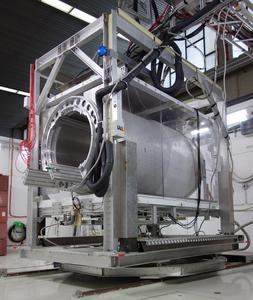Test Beam Area T24/1
Introduction
The DESY II testbeam can deliver electron or positron beams with an energy between 1 to 6 GeV. In the testbeam area T24/1, a test stand (see Figure 1) with a large bore 1 T solenoid has been set up. One initial funding source was the european EUDET project for detector development infrastructure. Futher support to improve and extend the setup came and come from also from the AIDA and the AIDA 2020 projects. One of the main users of this setup is the LCTPC collaboration.
The area hosts a sophisticated infrastructure consisting of equipment that is necessary in order to operate a gaseous detector according to the scientific program of the LCTPC collaboration. The setup comprises the superconducting 1T PCMAG solenoid. Including a cosmic trigger setup using scintillator slabs, this magnet mounted on a movable lifting stage that allows to use the electron test beam at different positions and under different angles inside the magnet.
The setup also includes a high voltage and a gas system including a slow control setup, as well as a beam trigger. In addition, a photo electron calibration system for the Large Prototype TPC is available. This consists of a pattern on the cathode plate, from which electrons are liberated when being illuminated by pulses from a UV laser. Since 2014 a 2-Phase CO2 colling device, called TRACI, is available. For the future, the inclusion of a silicon beam telescope inside the magnet coil is under development to be capable of doing independent track reference measurements.
The anode side end plate of the Large Prototype has been supplied by the University of Cornell. It is designed to house seven read-out modules of a shape and size comparable to one that could be used in the ILD TPC. They are arranged in three rows in the end plate, which have a curvature that corresponds to the radius of the outermost ring of readout modules in the ILD TPC end plates. More information about the end plate can be found on the web page at Cornell.
Several measurements with various read-out modules using different kinds of gas amplification and read-out techniques have been performed and more are planned. The results will be a crucial input to the design of the final ILD TPC.


